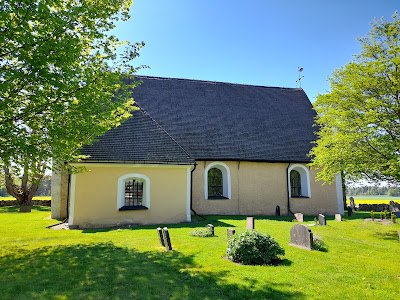The Last Survivor: the 1762 Organ at Hacksta Church, Sweden
A small parish church in the countryside of Grillby in the region of Uppsala houses a most precious organ which I had the pleasure to visit in May 2024. Hacksta church is a medieval church from the 13th century which was provided with an organ in the early 17th century. A new organ was commissioned in 1762 to the organist and organ builder Lars Kinström (1710-1763). The organ was built by his colleague and father-in-law Jacob Westervik (1736-1781). He completed a 7-stop positive organ with a single keyboard and without pedals. In 1790, the organ builder Matthias Swahlberg (1730-1800) restored the organ and changed the original stops Qvinta 1 1/3 and SuperOctava 1 for a Trompet 8 (divided in bass and treble), together with a bird effect and a pull-down pedalboard.
The baroque organ was modified in 1841 by Pehr Gullbergsson (1780-1864), before being dismantled in 1932 to offer space for a rather small pneumatic 2-manual organ in romantic style built by Erik Henrik Eriksson (1856-1936). The historical material was safely stored in the bell-tower, where it was discovered by chance by the Swedish organ builder Tomas Svenske in the early 2000’s. Everything was stored in a big mess but almost everything was in place: the keyboard, the action, the wind-chest, two bellows and almost all of the pipes. A whole baroque organ was waiting to be restored, including the 1790 reed stop. The original organ case was still in the church, now housing the 1932 organ. After further research and agreements made with the church council, the Eriksson organ was removed and the baroque organ was carefully restored and reinstalled in its original case in 2002 by Tomas Svenske as it was in the 1790 condition (but without the bird effect).
The internal layout of the pipes follows the disposition of the façade pipes with central cusp. The design and disposition reminds me of some of the smaller organs built by the famous German organ builder Gottfried Silbermann (1683-1753). It is most interesting to compare the original 1762 disposition in Hacksta (Gedacht 8, Principal 4, Fleut 4, Qvinta 3, Octava 2, Qvinta 1 1/3, SuperOctava 1) to the disposition of the 1734 Silbermann organ at Bremen Cathedral (Rohrflöte 8, Principal 4, Flöte 4, Nasate 2 2/3 from c1, Octave 2, Sesquialtera 1 3/5 from c1, Quinte 1 1/3, Sufflöte 1).
The organ at Hacksta church has a single keyboard with 49 keys (C-c3) and a pull-down pedalboard with 20 pedals (C-g). The current disposition is as follows:
Gedacht 8, Principal 4, Fleut 4, Quinta 3, Octava 2, Trompet 8 bass/treble
Here is a video with a sound excerpt of this lovely instrument which is today in very good playable condition. It has a great historical value in the Swedish organ building world because it is the only surviving instrument from Kinström and Westervik’s production.






